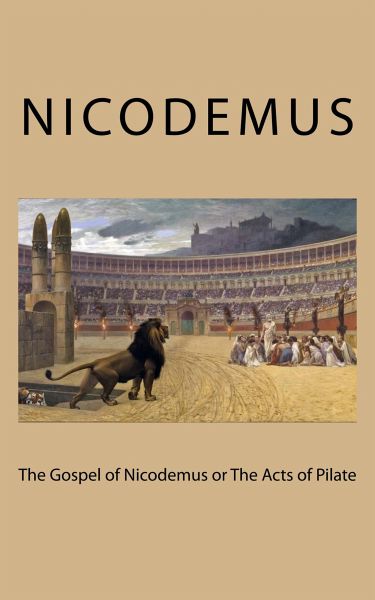
The Gospel of Nicodemus (eBook, ePUB)
or The Acts of Pilate

PAYBACK Punkte
0 °P sammeln!
The six documents inserted under this name are various forms of two books-two in Greek and one in Latin of the Acts of Pilate; one in Greek and two in Latin of the Descent of Christ to the world below. Of twelve mss., only two or three give the second part consecutively with the first, nor does it so appear in the Coptic translation. The title of Gospel of Nicodemus does not appear before the thirteenth century.Justin Martyr mentions a book called the Acts of Pilate, and Eusebius informs us that the Emperor Maximim allowed or ordered a book, composed by the pagans under this title, to be publi...
The six documents inserted under this name are various forms of two books-two in Greek and one in Latin of the Acts of Pilate; one in Greek and two in Latin of the Descent of Christ to the world below. Of twelve mss., only two or three give the second part consecutively with the first, nor does it so appear in the Coptic translation. The title of Gospel of Nicodemus does not appear before the thirteenth century.
Justin Martyr mentions a book called the Acts of Pilate, and Eusebius informs us that the Emperor Maximim allowed or ordered a book, composed by the pagans under this title, to be published in a certain portion of the empire, and even to be taught in the schools; but neither of these could have been the work under consideration.
Tischendorf attributes it to the second century, which is probably too early, though without doubt the legend was formed by the end of the second century. Maury (Mém. de la Société des Antiq. de France, t. xx.) places it in the beginning of the fifth century, from 405 to 420; and Renan (Études d' Hist. Relig., p. 177) concurs in this opinion. An able writer in the Quarterly Review (vol. cxvi.) assigns it to 439; the author of the article Pilate, in Smith's Bible Dictionary, gives the end of the third century as the probable date.
The author was probably a Hellenistic Jew converted to Christianity, or, as Tischendorf and Maury conclude, a Christian imbued with Judaic and Gnostic beliefs. The original language was most probably Greek, though, as in the case of Pseudo-Matthew, the History of Joseph the Carpenter, etc., the original language is, in many of the prefaces, stated to have been Hebrew. Some think that Latin was the original language, on the ground that Pilate would make his report to the Emperor in that, the official, language. The Latin text we have, however, is obviously a translation, made, moreover, by a man to whom Greek was not very familiar, as is obvious from several instances specified in our notes to the text.
The editio princeps of the Latin text is without place or date, and it has been re-edited by Jones, Birch, Fabricius, Thilo, and others. The Greek text of Part I., and of a portion of Part II., was first published by Birch, and afterwards in a much improved form, with the addition of copious notes and prolegomena, by Thilo. The latter part of his prolegomena contains a full account of the English, French, Italian, and German translations. For his edition Tischendorf consulted thirty-nine ancient documents, of which a full account is given in his prolegomena, pp. lxxi.-lxxvi.
For an interesting account of these documents, see the introduction to Mr. B. H. Cowper's translation of the Apocryphal Gospels, pp. lxxxv.-cii.
Justin Martyr mentions a book called the Acts of Pilate, and Eusebius informs us that the Emperor Maximim allowed or ordered a book, composed by the pagans under this title, to be published in a certain portion of the empire, and even to be taught in the schools; but neither of these could have been the work under consideration.
Tischendorf attributes it to the second century, which is probably too early, though without doubt the legend was formed by the end of the second century. Maury (Mém. de la Société des Antiq. de France, t. xx.) places it in the beginning of the fifth century, from 405 to 420; and Renan (Études d' Hist. Relig., p. 177) concurs in this opinion. An able writer in the Quarterly Review (vol. cxvi.) assigns it to 439; the author of the article Pilate, in Smith's Bible Dictionary, gives the end of the third century as the probable date.
The author was probably a Hellenistic Jew converted to Christianity, or, as Tischendorf and Maury conclude, a Christian imbued with Judaic and Gnostic beliefs. The original language was most probably Greek, though, as in the case of Pseudo-Matthew, the History of Joseph the Carpenter, etc., the original language is, in many of the prefaces, stated to have been Hebrew. Some think that Latin was the original language, on the ground that Pilate would make his report to the Emperor in that, the official, language. The Latin text we have, however, is obviously a translation, made, moreover, by a man to whom Greek was not very familiar, as is obvious from several instances specified in our notes to the text.
The editio princeps of the Latin text is without place or date, and it has been re-edited by Jones, Birch, Fabricius, Thilo, and others. The Greek text of Part I., and of a portion of Part II., was first published by Birch, and afterwards in a much improved form, with the addition of copious notes and prolegomena, by Thilo. The latter part of his prolegomena contains a full account of the English, French, Italian, and German translations. For his edition Tischendorf consulted thirty-nine ancient documents, of which a full account is given in his prolegomena, pp. lxxi.-lxxvi.
For an interesting account of these documents, see the introduction to Mr. B. H. Cowper's translation of the Apocryphal Gospels, pp. lxxxv.-cii.
Dieser Download kann aus rechtlichen Gründen nur mit Rechnungsadresse in A, B, BG, CY, CZ, D, DK, EW, E, FIN, F, GR, H, IRL, I, LT, L, LR, M, NL, PL, P, R, S, SLO, SK ausgeliefert werden.













